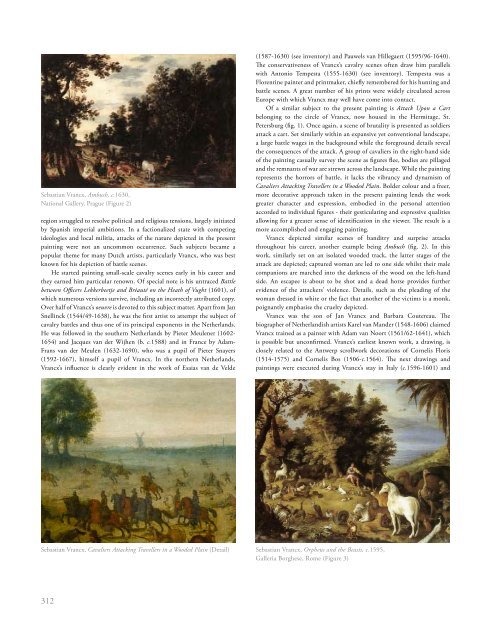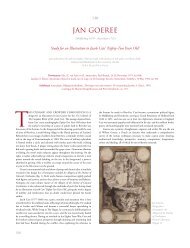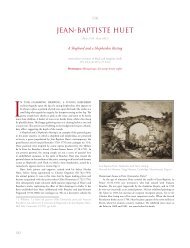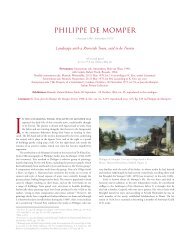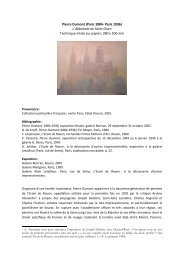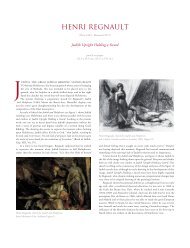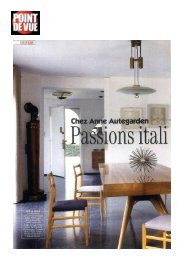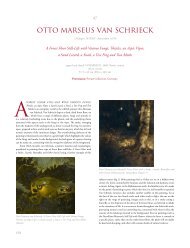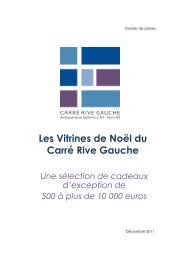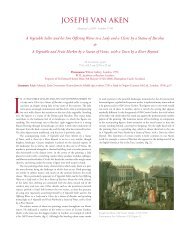SEBASTIAN VRANCX - Jacques d'Arthois - An Extensive Wooded ...
SEBASTIAN VRANCX - Jacques d'Arthois - An Extensive Wooded ...
SEBASTIAN VRANCX - Jacques d'Arthois - An Extensive Wooded ...
Create successful ePaper yourself
Turn your PDF publications into a flip-book with our unique Google optimized e-Paper software.
Sebastian Vrancx, Ambush, c.1630,<br />
National Gallery, Prague (Figure 2)<br />
region struggled to resolve political and religious tensions, largely initiated<br />
by Spanish imperial ambitions. In a factionalized state with competing<br />
ideologies and local militia, attacks of the nature depicted in the present<br />
painting were not an uncommon occurrence. Such subjects became a<br />
popular theme for many Dutch artists, particularly Vrancx, who was best<br />
known for his depiction of battle scenes.<br />
He started painting small-scale cavalry scenes early in his career and<br />
they earned him particular renown. Of special note is his untraced Battle<br />
between officers lekkerbeetje and Bréauté on the Heath of vught (1601), of<br />
which numerous versions survive, including an incorrectly attributed copy.<br />
Over half of Vrancx’s oeuvre is devoted to this subject matter. Apart from Jan<br />
Snellinck (1544/49-1638), he was the first artist to attempt the subject of<br />
cavalry battles and thus one of its principal exponents in the Netherlands.<br />
He was followed in the southern Netherlands by Pieter Meulener (1602-<br />
1654) and <strong>Jacques</strong> van der Wijhen (b. c.1588) and in France by Adam-<br />
Frans van der Meulen (1632-1690), who was a pupil of Pieter Snayers<br />
(1592-1667), himself a pupil of Vrancx. In the northern Netherlands,<br />
Vrancx’s influence is clearly evident in the work of Esaias van de Velde<br />
312<br />
(1587-1630) (see inventory) and Pauwels van Hillegaert (1595/96-1640).<br />
The conservativeness of Vrancx’s cavalry scenes often draw him parallels<br />
with <strong>An</strong>tonio Tempesta (1555-1630) (see inventory). Tempesta was a<br />
Florentine painter and printmaker, chiefly remembered for his hunting and<br />
battle scenes. A great number of his prints were widely circulated across<br />
Europe with which Vrancx may well have come into contact.<br />
Of a similar subject to the present painting is Attack Upon a Cart<br />
belonging to the circle of Vrancx, now housed in the Hermitage, St.<br />
Petersburg (fig. 1). Once again, a scene of brutality is presented as soldiers<br />
attack a cart. Set similarly within an expansive yet conventional landscape,<br />
a large battle wages in the background while the foreground details reveal<br />
the consequences of the attack. A group of cavaliers in the right-hand side<br />
of the painting casually survey the scene as figures flee, bodies are pillaged<br />
and the remnants of war are strewn across the landscape. While the painting<br />
represents the horrors of battle, it lacks the vibrancy and dynamism of<br />
Cavaliers Attacking Travellers in a <strong>Wooded</strong> Plain. Bolder colour and a freer,<br />
more decorative approach taken in the present painting lends the work<br />
greater character and expression, embodied in the personal attention<br />
accorded to individual figures - their gesticulating and expressive qualities<br />
allowing for a greater sense of identification in the viewer. The result is a<br />
more accomplished and engaging painting.<br />
Vrancx depicted similar scenes of banditry and surprise attacks<br />
throughout his career, another example being Ambush (fig. 2). In this<br />
work, similarly set on an isolated wooded track, the latter stages of the<br />
attack are depicted; captured woman are led to one side whilst their male<br />
companions are marched into the darkness of the wood on the left-hand<br />
side. <strong>An</strong> escapee is about to be shot and a dead horse provides further<br />
evidence of the attackers’ violence. Details, such as the pleading of the<br />
woman dressed in white or the fact that another of the victims is a monk,<br />
poignantly emphasise the cruelty depicted.<br />
Vrancx was the son of Jan Vrancx and Barbara Coutereau. The<br />
biographer of Netherlandish artists Karel van Mander (1548-1606) claimed<br />
Vrancx trained as a painter with Adam van Noort (1561/62-1641), which<br />
is possible but unconfirmed. Vrancx’s earliest known work, a drawing, is<br />
closely related to the <strong>An</strong>twerp scrollwork decorations of Cornelis Floris<br />
(1514-1575) and Cornelis Bos (1506-c.1564). The next drawings and<br />
paintings were executed during Vrancx’s stay in Italy (c.1596-1601) and<br />
Sebastian Vrancx, Cavaliers Attacking Travellers in a <strong>Wooded</strong> Plain (Detail) Sebastian Vrancx, orpheus and the Beasts, c.1595,<br />
Galleria Borghese, Rome (Figure 3)


